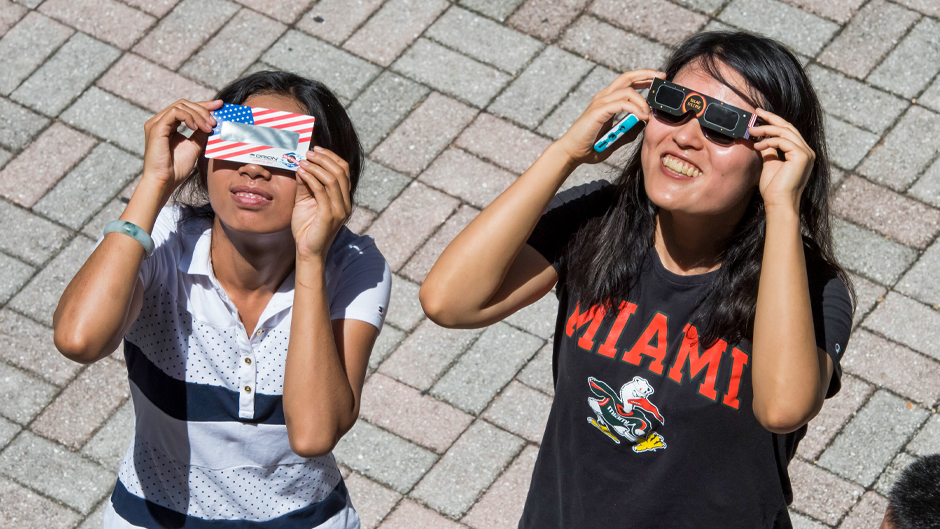Newswise — It will be the moon’s moment to shine.
On Monday, April 8, a celestial spectacle in the sky—a total solar eclipse—will occur when Earth’s only natural satellite passes in front of the sun, casting a shadow across parts of Mexico, the United States, and Canada.
During the extraordinary cosmic event, the sky will darken as if it were dawn or dusk.
An estimated 31.6 million people live within the roughly 100-mile-wide path of totality, or areas where the moon’s shadow will completely cover the sun, according to NASA. During totality, the sun’s corona—or outer atmosphere—becomes visible, offering scientists unique opportunities to study it.
“But even if you’re not in the path of totality, no worries. A partial eclipse, with the moon obscuring only part of the sun, is still a treat,” said Alessandro Peca, who graduates from the University of Miami this spring with a Ph.D. in astrophysics.
For the April 8 eclipse, every contiguous U.S. state, in addition to parts of Alaska and Hawaii, will experience at least a partial solar eclipse, according to NASA.
Peca will be at Horseshoe Bay, Texas, near the center of totality, presenting his research on supermassive black holes at a meeting of the High Energy Astrophysics Division of the American Astronomical Society. “While I’m super excited to share my research with fellow space enthusiasts, I can’t deny that the eclipse is a massive cherry on top,” he said. “It’s like the universe is throwing a cosmic party, and I’ve got VIP access.”
The total solar eclipse begins over the South Pacific Ocean, and weather permitting, the first location in continental North America that will experience totality is Mexico’s Pacific coast at approximately 11:07 a.m. PDT.
For Miami, which will experience a partial solar eclipse, the spectacular show in the sky begins at around 1:47 p.m. and ends at 4:13 p.m., with the peak occurring at 3:01 p.m.
Eye safety for the solar eclipse
If you’re planning to watch the cosmic show—the next total solar eclipse to reach the lower 48 states will not occur until 2044—you will need to wear specialized eye protection. Ordinary sunglasses, even if they are very dark, or homemade filters are not safe for looking at the sun, according to the American Academy of Ophthalmology (AAO).
“There is only one safe way to look directly at the sun, whether during an eclipse or not: through special-purpose solar filters. These solar filters are used in eclipse glasses or in hand-held solar viewers. They must meet a very specific worldwide standard known as ISO 12312-2,” according to the AAO’s website.
Also, if you plan to watch the solar eclipse through a camera lens, binoculars, or a telescope, make certain that it has a special-purpose solar filter, according to NASA.
Read more about proper eclipse glasses and where they can be purchased.
If you don’t plan to get eclipse glasses or a handheld solar viewer, you can still view the solar eclipse using an indirect viewing method, such as a pinhole projector, which does not involve looking directly at the sun.
Dr. Craig A. McKeown, a pediatric ophthalmologist at Bascom Palmer Eye Institute, part of the University of Miami Health System, had some advice for parents.
“Only children who are old enough to follow instructions and keep their solar-eclipse glasses on should be allowed to watch the eclipse under adult supervision,” McKeown said. “Parents of babies and toddlers should remain inside with the children and consider watching the eclipse on television.”
NASA will broadcast the eclipse live.
Dr. Nell Gregori, a professor of clinical ophthalmology at Bascom Palmer Eye Institute and the Lois Pope Endowed Chair for Age-Related Macular Degeneration Research, answered questions about how the sun can damage the eye and how to properly view the solar eclipse.
How does the sun damage the eye if you look directly at it?
The sun is incredibly powerful. It can cause permanent damage to the eye if proper eye protection is not used. The damage can happen in a matter of seconds. When looking directly at the sun, you are at risk for solar retinopathy, or retinal burns caused by high-intensity light. The eye sees by absorbing light; light passes through the pupil and lens to the back of the eye, called the retina. The retina contains light sensitive cells called rods and cones that create nerve signals telling the brain what is being seen. When looking directly at the sun, the sun’s powerful rays travel through the eye to the retina. The intense exposure triggers a series of complex chemical reactions in the eye that damage the light-sensitive rod and cone cells that help see. Burning the retina can lead to temporary or permanent central vision loss. Symptoms may not appear until a few hours after exposure and include a blur or blind spots right in the center of one’s vision as well as distorted vision or altered color vision in one or both eyes. Using solar eclipse lenses allow you to watch a solar eclipse safely.
How do eclipse glasses work?
Eclipse glasses use special-purpose solar filters to filter out light and protect your eyes. No more than 0.00032 percent of the sun’s light may be transmitted through the filters. Make sure you are only using eclipse glasses that meet the specific worldwide standard known as ISO 12312-2; regular sunglasses, even if very dark, do not protect you when watching the solar eclipse, even if squinting. ISO 12312-2 standard requires a certain level of transmittance (the ratio of transmitted light to incident light) at the ultraviolet, visible, and infrared wavelengths that reach the retinas.
How is solar retinopathy treated?
Unfortunately, there is no treatment for solar retinopathy. Sun rays are incredibly powerful, and the damage is difficult to undo. Some eyes can undergo some healing. However, full recovery is rare. That’s why educating the public on the importance of wearing proper eye protection when watching the solar eclipse is so important.

